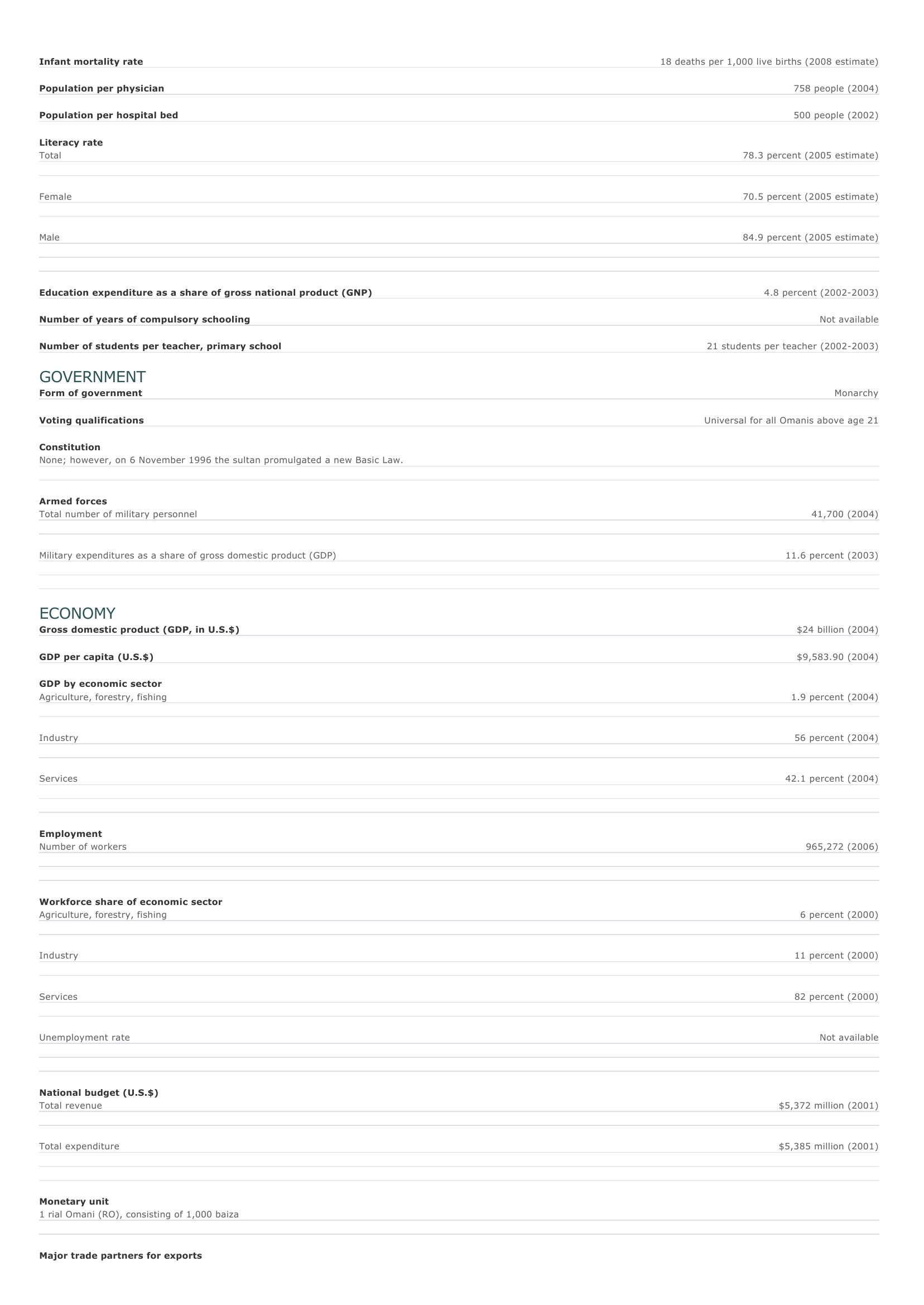Oman Facts and Figures. BASIC FACTS Official name Capital Area Sultanate of Oman Masqa? 309,500 sq km 119,500 sq mi PEOPLE Population 3,309,440 (2008 estimate) Population growth Population growth rate 3.19 percent (2008 estimate) Projected population in 2025 5,294,475 (2025 estimate) Projected population in 2050 8,337,734 (2050 estimate) Population density 16 persons per sq km (2008 estimate) 40 persons per sq mi (2008 estimate) Urban/rural distribution Share urban 77 percent (2003 estimate) Share rural 23 percent (2003 estimate) Largest cities, with population Masqa? 638,000 (2003 estimate) Ethnic groups Omani Arab 75 percent Indian, Pakistani, Sri Lankan, Bangladeshi 21 percent Iranian, Egyptian, Somali, other 4 percent Languages Arabic (official), English, Baluchi, Urdu, Hindi, other dialects Religious affiliations Ibadi Muslim (Islam is the official religion) 75 percent Other Muslim (Shia and Sunni) 13 percent Hindu 6 percent Christian 5 percent O ther 1 percent HEALTH AND EDUCATION Life expectancy Total 73.9 years (2008 estimate) Female 76.3 years (2008 estimate) Male 71.6 years (2008 estimate) Infant mortality rate 18 deaths per 1,000 live births (2008 estimate) Population per physician 758 people (2004) Population per hospital bed 500 people (2002) Literacy rate Total 78.3 percent (2005 estimate) Female 70.5 percent (2005 estimate) Male 84.9 percent (2005 estimate) Education expenditure as a share of gross national product (GNP) Number of years of compulsory schooling Number of students per teacher, primary school 4.8 percent (2002-2003) Not available 21 students per teacher (2002-2003) GOVERNMENT Form of government Monarchy Voting qualifications Universal for all Omanis above age 21 Constitution None; however, on 6 November 1996 the sultan promulgated a new Basic Law. Armed forces Total number of military personnel Military expenditures as a share of gross domestic product (GDP) 41,700 (2004) 11.6 percent (2003) ECONOMY Gross domestic product (GDP, in U.S.$) $24 billion (2004) GDP per capita (U.S.$) $9,583.90 (2004) GDP by economic sector Agriculture, forestry, fishing 1.9 percent (2004) I ndustry 56 percent (2004) Services 42.1 percent (2004) Employment Number of workers Workforce share of economic sector Agriculture, forestry, fishing 965,272 (2006) 6 percent (2000) I ndustry 11 percent (2000) Services 82 percent (2000) Unemployment rate Not available National budget (U.S.$) Total revenue $5,372 million (2001) Total expenditure $5,385 million (2001) Monetary unit 1 rial Omani (RO), consisting of 1,000 baiza Major trade partners for exports Japan, South Korea, China, Thailand, and Singapore Major trade partners for imports United Arab Emirates, Japan, United Kingdom, United States, and Germany ENERGY, COMMUNICATIONS, AND TRANSPORTATION Electricity production Electricity from thermal sources 100 percent (2003 estimate) Electricity from hydroelectric sources 0 percent (2003 estimate) Electricity from nuclear sources 0 percent (2003 estimate) Electricity from geothermal, solar, and wind sources 0 percent (2003 estimate) Number of radios per 1,000 people 607 (1997) Number of telephones per 1,000 people 103 (2005) Number of televisions per 1,000 people 565 (2000 estimate) Number of Internet hosts per 10,000 people 2.8 (2003) Daily newspaper circulation per 1,000 people 27 (1996) Number of motor vehicles per 1,000 people Paved road as a share of total roads 142 (1997) 28 percent (2001) SOURCES Basic Facts and People sections Area data are from the statistical bureaus of individual countries. Population, population growth rate, and population projections are from the United States Census Bureau, International Programs Center, International Data Base (IDB) (www.census.gov). Urban and rural population data are from the Food and Agriculture Organization (FAO) of the United Nations (UN), FAOSTAT database (www.fao.org). Largest cities population data and political divisions data are from the statistical bureaus of individual countries. Ethnic divisions and religion data are largely from the latest Central Intelligence Agency (CIA) World Factbook and from various country censuses and reports. Language data are largely from the Ethnologue, Languages of the World, Summer Institute of Linguistics International (www.sil.org). Health and Education section Life expectancy and infant mortality data are from the United States Census Bureau, International Programs Center, International database (IDB) (www.census.gov). Population per physician and population per hospital bed data are from the World Health Organization (WHO) (www.who.int). Education data are from the United Nations Educational, Scientific and Cultural Organization (UNESCO) database (www.unesco.org). Government section Government, independence, legislature, constitution, highest court, and voting qualifications data are largely from various government Web sites, the latest Europa World Yearbook, and the latest Central Intelligence Agency (CIA) World Factbook. The armed forces data is from Military Balance. Economy section Gross domestic product (GDP), GDP per capita, GDP by economic sectors, employment, and national budget data are from the World Bank database (www.worldbank.org). Monetary unit, agriculture, mining, manufacturing, exports, imports, and major trade partner information is from the statistical bureaus of individual countries, latest Europa World Yearbook, and various United Nations and International Monetary Fund (IMF) publications. Energy, Communication, and Transportation section Electricity information is from the Energy Information Administration (EIA) database (www.eia.doe.gov). Radio, telephone, television, and newspaper information is from the United Nations Educational, Scientific and Cultural Organization (UNESCO) database (www.unesco.org). Internet hosts, motor vehicles, and road data are from the World Bank database (www.worldbank.org). Note Figures may not total 100 percent due to rounding. Microsoft ® Encarta ® 2009. © 1993-2008 Microsoft Corporation. All rights reserved.



